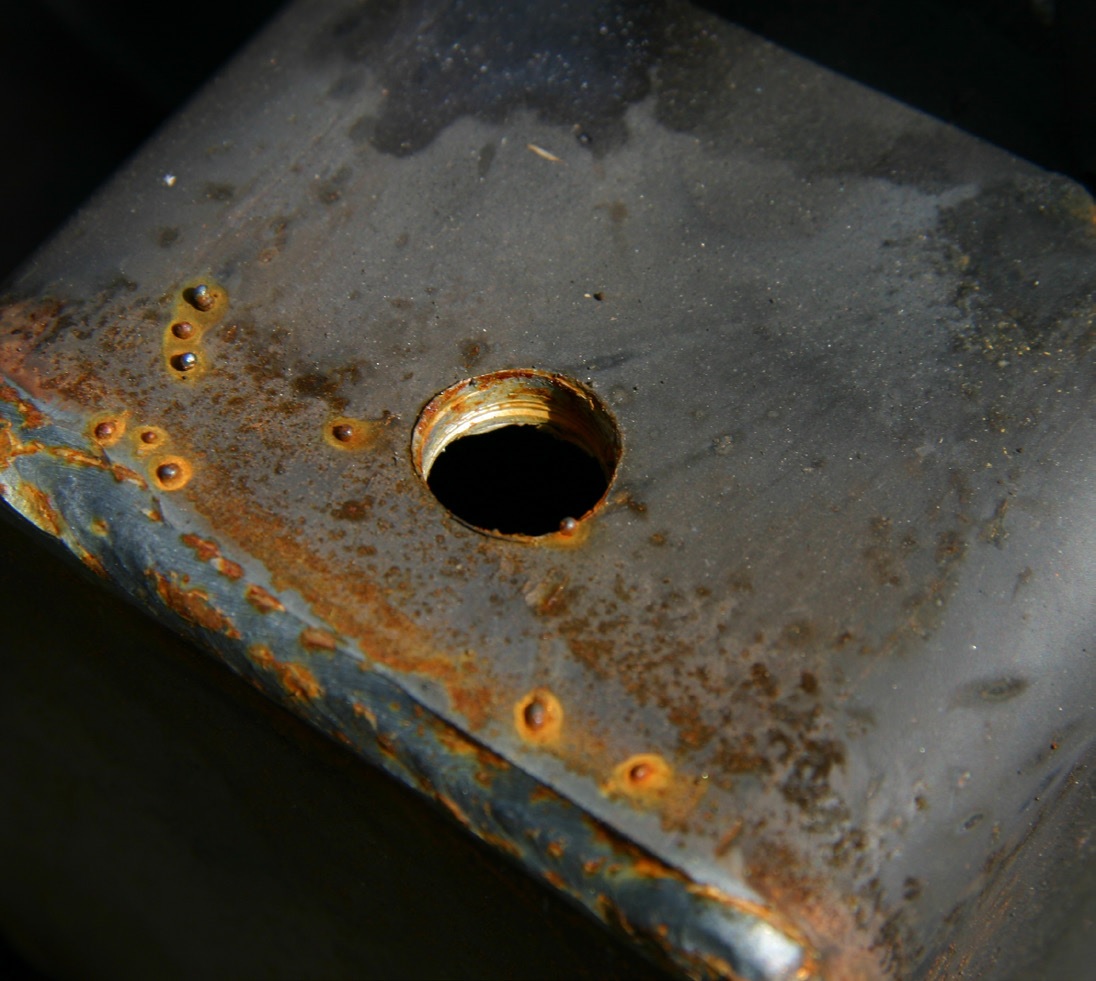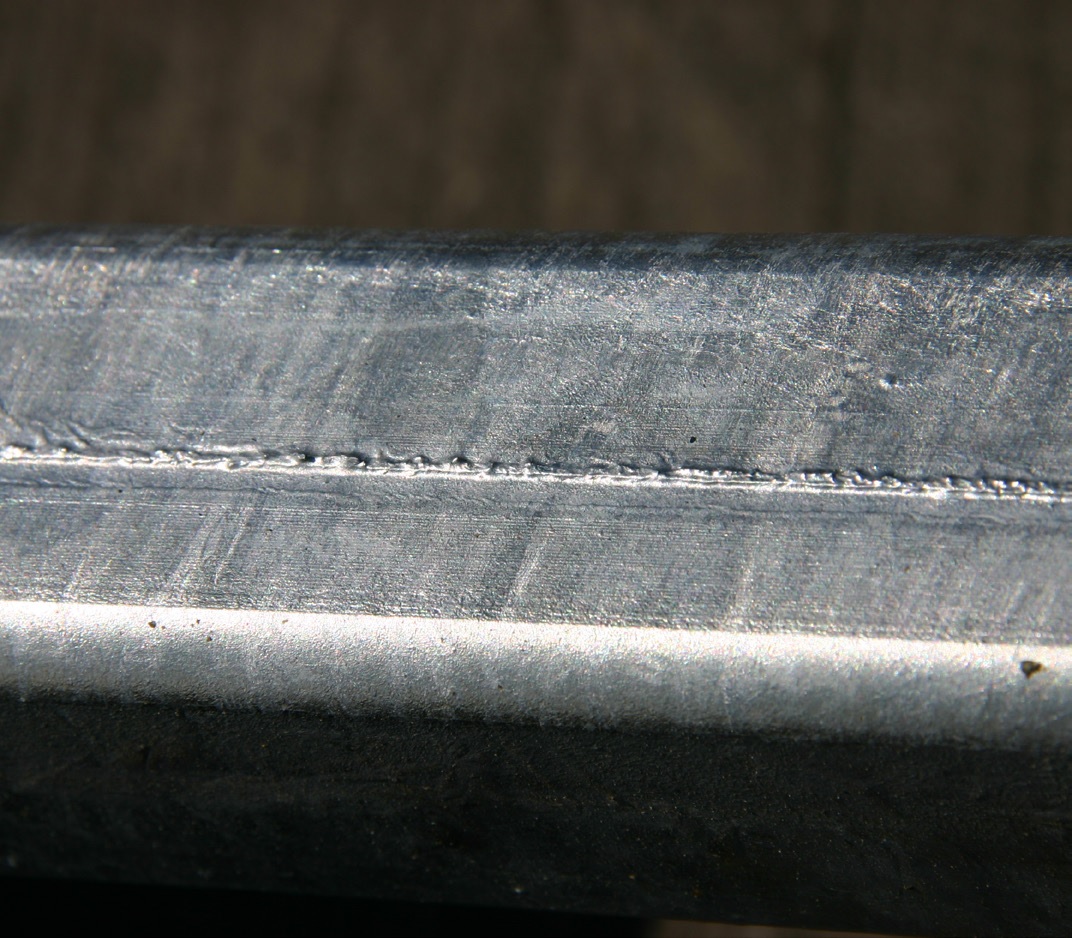
A proportion of steelwork that is hot dip galvanized is subject to fabrication by welding prior to dipping. The welding process can affect galvanizing in terms of coating quality, distortion and creating an increased potential for cracking in isolated instances. By taking suitable actions these issues may be alleviated.
Coating Quality
During the welding process a weld slag may sometimes be deposited onto the steel surface. This deposit will not be removed by the normal pretreatment process and will result in uncoated areas. It is therefore essential that all signs of welding slag are removed prior to sending work for hot dip galvanizing. When welding steelwork prior to hot dip galvanizing often a weld anti-spatter spray is used (Image 1). This may be of benefit in terms of achieving a more even finish when galvanizing. However, some weld anti-spatter sprays may burn onto the steel surface such that it is not visible to the naked eye and as they are not removed by the normal pretreatment process result in uncoated areas.

Weld spatter present on steel before galvanizing
Issues with weld anti-spatter sprays (image 2) have been associated with oil based and silicone containing weld anti-spatter sprays. This problem may be avoided by the use of a water based or water soluble weld anti-spatter spray which will normally come off during the normal pre-treatment process and details of product suppliers is available from Galvanizers Association upon request.
Where a welding consumable is used, this may also affect the coating finish as most welding electrodes have a high silicone content. As a result, the weld metal deposited may be significantly more reactive than parent metal leading to an increased coating thickness locally at the weld (Images 3 and 4). In some cases, where welds have been ground flush the increased coating growth can make it look as though such work has not been undertaken. This issue may be avoided by using low silicone welding consumables and details of suppliers is available from Galvanizers Association upon request.

Area of weld spatter not removed prior to galvanizing
Distortion
The welding process can introduce stresses into steel fabrications which in some cases may be sufficiently high enough to lead to distortion during the hot dip galvanizing process. It is important that the stresses introduced should be as low as is practically possible and also have a balanced distortion. This may be achieved by minimizing the length and size of welds and using a balanced welding technique. Further details on avoidance of distortion may be found in this article.
Cracking
The occurrence of cracking during the galvanizing process is a rare event. However, the quality of welding can be contributory factor towards cracking taking place but by following some simple guidelines the already low frequency of occurrence may be further reduced. Welding should be conducted in accordance with the National Structural Steelwork Specification (NSSS) and by so doing a good quality weld will be produced.
Some points for consideration are:
- Ensuring welding rods are dry prior to use so as to avoid potential hydrogen pick-up
- Ensuring that heat input and the size of welds is kept to a minimum so as to reduce the level of stress created within the fabrication
- Welds are ground to remove any surface defects which might act as crack initiation points
Where holes are introduced these should ideally be drilled, or where holes are punched they should be reamed out prior to galvanizing. Flame burning of holes should be avoided as this produces hardened surfaces with surface defects. The use of square holes should also be avoided wherever possible as the corners may act as stress raisers from which cracks might be initiated. Where copes are cut, these should have as large a radius as is practically possible and their surface should be ground to remove any hardened surface and defects which might act as stress raisers.

Build-up of the galvanized coating along the weld seam of a box section
Welding Hot Dip Galvanized Steel
It is best practice to try and ensure all fabrication take place prior to hot dip galvanizing. Normally, taking into account the need for design for galvanizing, this can be achieved so ensuring the continuity of the galvanized coating over the whole of the article. However, in individual cases it may be necessary to make alterations to a galvanized component or to join two separate galvanized components such that welding will be required.
Issues with Welding Galvanized Steel
Where galvanized steelwork must be welded the main issues of concern are:
- Damage to the galvanized coating that will take place due to the heat of the welding process
- Potential for embrittlement of the weld if zinc becomes entrained within the weld pool
- Perceived health and safety issues associated with welding galvanized steel
In some instances, if the joint is not load bearing or critical, entrained zinc may not be a significant problem. However, the points below highlight best practice which would minimize the potential for zinc becoming entrained in the weld pool and also mitigate against health and safety concerns:
- Good ventilation should be maintained where galvanized steelwork is welded in an internal environment
- Remove the galvanized coating for a distance of at least 25 mm either side of the intended weld. The most efficient means of zinc removal is by burning off with a welding torch, although in practice the coating is often removed by abrasive means such as grinding
- Where abrasive grinding is used, it is possible some residual zinc may be left on the surface
- A small increase in the welding current may be made to help maintain the welding arc`s stability
- The welding speed should be reduced if the galvanized coating has not been removed locally
For butt welds the distance between galvanized steel parts to be welded should be slightly increased than would otherwise be the case if the galvanized coating has not been removed locally. Where coated electrodes are used, basic coated low hydrogen electrodes are preferred for structural steels which will not be subject to heavy loading. The use of rutile cellulose coated electrodes should be avoided.
After welding, the weld area should be cleaned to remove welding slag and any other surface contaminants prior to repair being conducted, typically using a suitable zinc-rich paint or paste to achieve a minimum repair coating thickness of 100 μm.

A weld that was ground flush prior to galvanizing. The high silicone content of the weld metal has then led to a thicker coating forming locally
Welding Techniques
Where an automated arc welding procedure with open or shielded, arcs is used, best results might be obtained by increasing the separation between the pieces to be welded and by reducing the welding speed.
Where Metal Active Gas (MAG) welding is conducted, ideally the shielding gas should be a carbon dioxide-argon mix (circa 20% CO2 80% Ar) with reduced welding speed and an increase of about 1-2 mm in workpiece separation. A slight oscillating movement of the wire electrode may also be of benefit. Use of a suitable weld anti-spatter spray may also be beneficial especially when short arc CO2 welding.
Tungsten Inert Gas (TIG) is not recommended for galvanized steels as the zinc oxide vapour has a detrimental effect upon the arc and may damage the tungsten electrode. In general terms, good results can be obtained when welding galvanized steel using a variety of methods, although small changes in welding practice as highlighted above will be of benefit, the operator progressing up a learning curve to establish the correct parameters.
Learn more
You can find more information about Hot Dip Galvanizing on Galvanizing Association website



